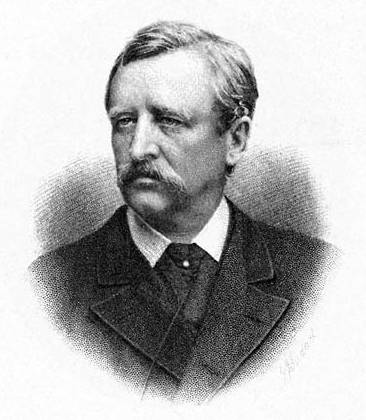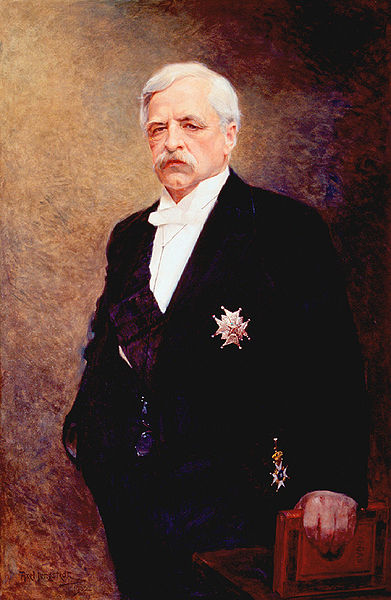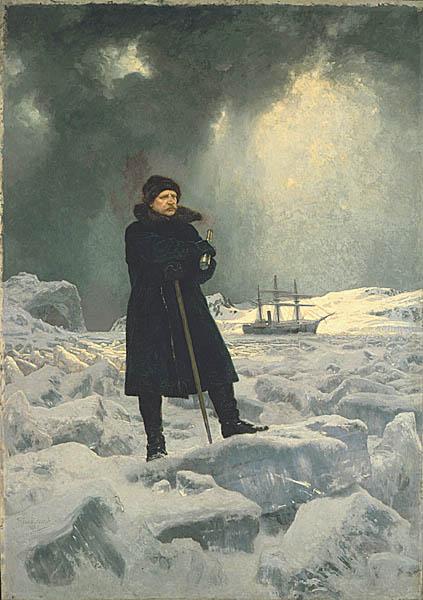<Back to Index>
- Explorer Adolf Erik Nordenskiöld, 1832
- Photographer Louis Jacques Mandé Daguerre, 1787
- Prime Minister of Italy Alfonso Ferrero, Cavaliere La Màrmora, 1804
PAGE SPONSOR



Baron (Nils) Adolf Erik Nordenskiöld, also known as A.E. Nordenskioeld (18 November 1832, Helsinki, Finland – 12 August 1901, Dalbyö, Södermanland, Sweden) was a Finnish-Swede geologist, mineralogist and arctic explorer, and a member of the prominent Finland-Swedish Nordenskiöld family of scientists. Born in the Grand Duchy of Finland at the time it was a part of the Russian Empire, he was later, due to his political activity, forced to live in political exile in Sweden, where he later would become a member of the Parliament of Sweden. He is most remembered for the Vega expedition along the northern coast of Eurasia, which he led in 1878 - 1879. This was the first complete crossing of the Northeast Passage.
The Nordenskiölds were an old Swedish family, and members of the nobility. Nordenskiöld's father, Nils Gustav Nordenskiöld, was a prominent Finnish mineralogist, civil servant, and traveller. He was also a member of the Russian Academy of Sciences. Adolf Erik was the father of Gustaf Nordenskiöld (explorer of Mesa Verde) and Erland Nordenskiöld (ethnographer of South America) and maternal uncle of Nils Otto Gustaf Nordenskjöld (another polar explorer [note the different spelling of the latter's family name]). Nordenskiöld was born in 1832 in Helsinki, the capital of Finland, but he spent his early youth on the family estate in Mäntsälä. He went to school in Porvoo, a small town on the south coast of Finland. He then entered the Imperial Alexander University in Helsinki in 1849 where he studied mathematics, geology, and applied himself especially to chemistry and mineralogy. He received his masters degree in 1853. Two years later, he published his dissertation, entitled "Om grafitens och chondroditens kristallformer" (On the crystal forms of the graphite and chondrodite). Upon his graduation, in 1853, Nordenskiöld accompanied his father to the Ural Mountains and studied the iron and copper mines at Tagilsk;
on his return he received minor appointments both at the university and
the mining office. In 1856, Nordenskiöld was appointed Docent in
Mineralogy at the university. However, for political reasons he had to
flee in the following year to Sweden, where he was called to the office
of Director of the Mineralogical Department of the Swedish Museum of Natural History and to a professorship in Mineralogy at the Swedish Academy of Sciences. He married in 1863 Anna Maria Mannerheim, the aunt of Carl Gustaf Emil Mannerheim. Having studied for Runeberg he belonged to Liberal, anti-tsarist circles that agitated for Finland's liberation from Russia by the Swedes during the Crimean War; and an unguarded speech at a convivial entertainment in 1855 drew the attention of the Imperial Russian authorities to his political views, and led to a dismissal from the university. He then visited Berlin,
continuing his mineralogical studies, and in 1856 obtained a travelling
stipend from the university in Helsinki and planned to expend it in
geological research in Siberia and Kamchatka.
Upon returning he took his master's and doctor's degree in 1857 as a
scholar of chemistry and geology, specializing in iron and
copper-mining. He then aroused the suspicion of the authorities again,
so that he was forced to leave Finland, practically as a political refugee, and was deprived of the right of ever holding office in the university of Finland. As Nordenskiöld spoke Swedish as his mother tongue, a natural place for him to settle was nearby Stockholm. He soon received an offer from Otto Torell, the geologist, to accompany him on an expedition to Spitsbergen. To the observations of Torell on glacial phenomena Nordenskiöld added the discovery at Bell Sound of remains of Tertiary plants,
and on the return of the expedition he received the appointment of
professor and curator of the mineralogical department of the Swedish Museum of Natural History (Naturhistoriska Riksmuseet). Nordenskiöld's
participation in three geological expeditions to Spitsbergen, followed
by longer Arctic explorations in 1867, 1870, 1872 and 1875, led him to
attempt the discovery of the long-sought Northeast Passage. This he accomplished in the voyage of the Vega, navigating for the first time the northern coasts of Europe and Asia. Starting from Karlskrona on 22 June 1878, the Vega doubled Cape Chelyuskin in the following August, and after being frozen in at the end of September near the Bering Strait,
completed the voyage successfully in the following summer. He edited a
monumental record of the expedition in five volumes, and himself wrote
a more popular summary in two volumes. On his return to Sweden he received an enthusiastic welcome, and in April 1880 was made a baron and a commander of the Order of the North Star. In 1883, he visited the east coast of Greenland for
the second time, and succeeded in taking his ship through the great ice
barrier, a feat attempted in vain during more than three centuries. The
captain on the Vega expedition, Louis Palander, was made a nobility at the same time, and took the name Palander af Vega. In 1893, Baron Nordenskiöld was elected to the 12th chair of the Swedish Academy. The Laptev Sea had been originally named "Nordenskiöld Sea" (Russian: мо́ре Норденшельда), after this Arctic explorer. The Nordenskiöld Archipelago and the Nordenskiöld crater on Mars were also named in his honor. The A.E. Nordenskiöld Collection of maps is located at the University of Helsinki, and it was inscribed on UNESCO’s Memory of the World Register in 1997.